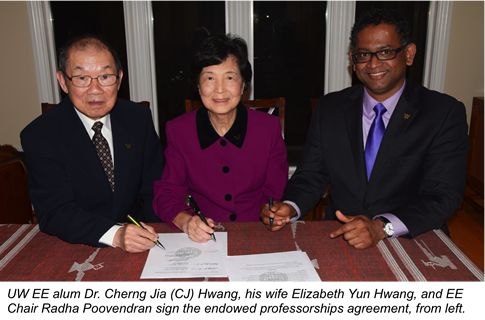 Multiple new professorships have been established in the area of rehabilitation technologies for spinal cord injury, department chair Radha Poovendran announced on November 19, 2015.
Multiple new professorships have been established in the area of rehabilitation technologies for spinal cord injury, department chair Radha Poovendran announced on November 19, 2015.
The Cherng Jia and Elizabeth Yun Hwang Endowed Professorship was created by gifts from alums Dr. Cherng Jia (CJ) Hwang (EE Ph.D. ’66) and his wife, Elizabeth Yun Hwang (MLIS ’65).
“We are very grateful that CJ and Elizabeth have made this timely contribution as the department continues to hire transformative faculty who are leaders in the biosystems related to rehabilitation and medical devices,” Poovendran said.
The establishment of the endowed professorships was inspired by the Hwangs’ daughter, Karen, who is a quadriplegic following a car accident in 1988. With the goal of improving the quality of life for people living with spinal cord injury, the Hwang family is determined to be the catalyst behind advancements for the estimated 300,000 people in the U.S. living with some form of spinal cord injury.
Raised in a small town in central Taiwan, CJ moved to the United States in 1962. Enrolling in UW EE graduate courses, he completed his master’s degree in 1964. During his graduate studies, where CJ researched impurity diffusion in semiconductors, he received much guidance from his advisor, Dr. Lynn A.K. Watt. In 1966, CJ was the first student from Taiwan to receive his Ph.D. from UW EE.
Following graduation, CJ accepted a position with Bell Telephone Laboratories in Murray Hill, New Jersey, where he worked on semiconductor laser research and development. During his seven years at Bell Labs, CJ designed the first long-life lasers. In 1973, he accepted a position with Hewlett Packard Laboratories and worked on the development and applications of semiconductor lasers. While at H-P, CJ received a UNESCO Fellowship, which allowed him to serve as a visiting professor for the Institute de Fisica at the University of Campinas, Brazil.
Motivated to start his own business, CJ went on to found three companies during his career: General Optronics Corp, which was the world’s first semiconductor laser manufacturer; Applied Optronics Corp, the world’s first company producing high power semiconductor lasers and subsystems for medical surgical applications; and Optronics International Corp, the first Taiwanese company developing and commercializing semiconductor lasers and subsystems for high-speed fiber optic communications.
CJ holds three patents, two from the U.S. and one from Taiwan. During his career, CJ published 52 technical papers in various widely respected journals, such as the Journal of Applied Physics and the Physical Review. From 1994 to 2003, CJ served as a member of the review board for the Division of Engineering, National Science Council, in Taiwan. He was also listed in many issues of Who’s Who and American Men and Women In Sciencesfrom 1979 to 1994.

